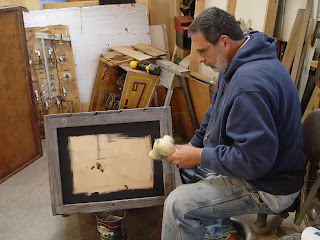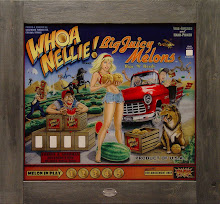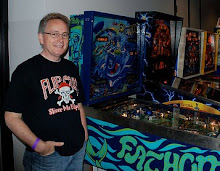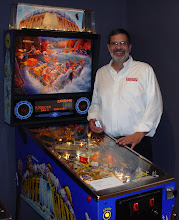After Dennis finished the sketch for the new "stack-o-crates" configuration, he thought about doing a small scale mock-up that we could take to the Pinball Expo in mid-October and unveil our idea to the "world". I called Rob Berk, organizer of the Expo, and asked if there were any time slots available for a short presentation regarding a project we wanted to share with the attendees. We had already agreed to do a presentation on our combined projects from our days at Bally and Williams, something that Rob titled "Evolution of the Party Animals", so we weren't sure if people would show up to a separate talk by the same two guys. Rob graciously agreed and gave us a spot on Friday evening and decided to title it, "The Unveiling of Project X". We now had a deadline and Dennis immediately upped the ante by deciding to get the reconstructed cabinet completed for the show!
Dennis describes the the steps he took in his own words:
When I did the cabinet sketch, I eliminated the standard legs and made a crate for the base. The idea was to give the cabinet a look of stacked up fruit crates and I felt that eliminating the legs was the perfect way to create the beginning of a really unique profile.

At first, the base cabinet had solid walls but Greg suggested adding slats with openings so he could add melon art to make the crate look like it was full of melons - a great idea!
I built the base cabinet using ¾ inch plywood to provide stability and mounted the original leg levelers to the bottom. I added a frame and slats on the sides to give it that crate look. We used actual crate labels for mock-up purposes only until Greg could provide his own version of labels for the Whoa Nellie Brand.

I distressed this crate the same way I did the main cabinet (See below). We wanted this crate to look different from the main cabinet for aesthetic variety. Instead of staining, I gave it a wash of light and medium grey latex paint. When that was dry, I gave it a wash of black latex paint and immediately rubbed it off with a towel. This "wipe" process highlighted all the cracks and crevices adding to the weathered look I wanted to achieve.

The main cabinet of the Continental Cafe game is slanted on the top, from back to front (like all pingames). But I wanted the cabinet to be ‘square’ like most crates. With the cabinet flat on top, there were two ways to provide the proper angle for the playfield. One was to drop the front of the playfield 3.5 degrees into the cabinet. The other way was to keep the playfield parallel with the top of the cabinet, and raise the back of the cabinet from underneath to obtain the 3.5 degrees. I decided I liked the look of the back of the cabinet being propped up by an old 2x4 - it adds an element of 'local authenticity' - like somebody built a pinball machine from a pile of fruit crates.
My first step was to pull everything out of the cabinet and take lots of pictures so I could get it all back together again. I also pulled out the rear glass support and playfield stop cross-piece. After I cut off the angled part of the cabinet I’d have to re-position this cross-piece later in the process.

(Note: The above photo represents the reconstructed cross-piece.)
I took a lot of measurements and decided I could make the main cabinet a little thinner for better visual proportions. I clamped some guide boards for the saw to the cabinet parallel to the bottom and cut off the top angled portion of the cabinet. Then I hand chiseled new grooves in the cabinet to remount the glass and playfield stop cross- piece. When I got done, I thought the cabinet looked pretty good.
It was then that I realized that I had paid no attention to the ball serve channel routed into the side of the cabinet. (For the unfamiliar, when these games were made, the ball serve mechanism was not automated - the player pushed a rod forward that would lift the ball to the top of the playfield in front of the plunger.) I had cut off the top quarter of the channel meaning I’d have to re-position and re-rout a new channel.


At this point it was time to remove the paint from the outside of the cabinet. (Although now I think this step was not necessary.) I could strip it or I could sand it. I’ve stripped lots of furniture and it’s a pretty messy process. It was a nice day so I decided to sand it outdoors in my driveway. There was a slight breeze so all the sawdust would blow into my neighbor’s yard. Perfect conditions! I plugged in my random-orbital sander and got to work.


After that was done, I started cutting the frame work for the crate. The 1.5 by .75 boards were cut from some cedar lumber I had saved from an old deck. After the pieces were cut to the proper length I started to distress them to look like an old crate. There is a gravel area near my shop and I placed the boards on the ground and jumped, stomped, and kicked them around to create random dents and scratches.
(Note: We apologize for not documenting the above, possibly very entertaining part of the process.)

I then used a propane torch to lightly burn the wood strips to help add to the illusion of aged wood and then scrubbed the strips with a wire brush to leave raised grain. This gives the appearance of a nice worn and weathered look.


The final step was to wipe on a walnut stain to darken the wood. I glued and nailed the strips to the cabinet and it began to take shape. I also had to cut a channel in the two pieces that go on the top of the cabinet to create a channel for the glass to slide in.




I asked Greg to get full-size prints made of the label art that we borrowed for mock-up purposes only, and we had a label day at my shop. The vision I had from my original sketch began to live in the real world and we started to get really excited about the future of this project.




(Note: The above base cabinet is before Dennis added the slats to the sides. Also note the all-important angle-providing 2x4.)
Unfortunately, I began to run out of time to get the entire cabinet completed for Pinball Expo 2009. While Greg worked on a backglass layout, title design, and label art for the base cabinet, I continued to make as much progress on the rest of the cabinet as I could. I still had to figure out how to rework the lockdown bar at the front of the cabinet to work with the rest of the design aesthetic, design and build the backbox and get the insert panel updated so Greg could work on backglass layout progress, and figure out how to finish the front of the playfield cabinet and coin door area.

Next: Prepping for Pinball Expo and further cabinet progress.
Photos by G. Freres and D. Nordman
Continental Cafe flyer courtesy of IPDB.com
Fruit crate labels (used for presentation mock-up only), Western Hoe and Best Point, found on various websites.

















































